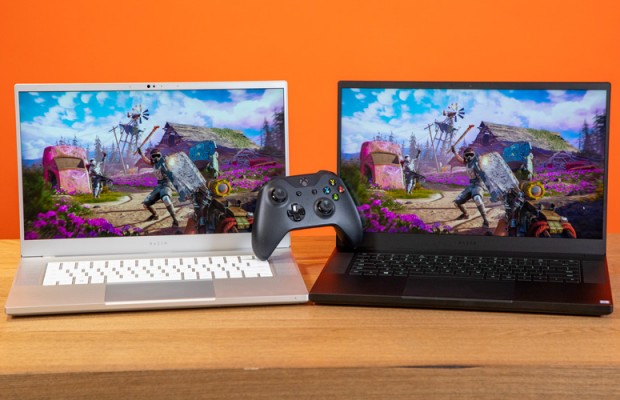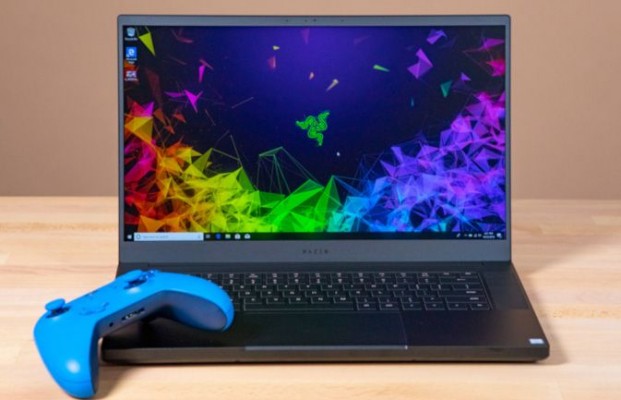Nvidia RTX 2070 vs. GTX 1070: Which Max-Q GPU is Right for You?
Nvidia’s RTX (Turing) cards have arrived, promising more power than its Pascal chips. Dubbed Turing by Nvidia, the company says these are its fastest GPUs ever, thanks in part to structural efficiencies and advanced shaders. Powerful performance and smoother, faster gameplay are some of the most obvious benefits. But thanks to some technological advancements, games have taken a serious step forward on the path to photorealism.
However, with a relatively small catalog of games that support Nvidia’s new tech and with a rather high price tag for the luxury, some gamers might want to stick with good ol' Pascal for the time being. Here’s what you need to know about Nvidia GeForce GTX 1070 Max-Q and RTX 2070 Max-Q graphics cards.
Specs Compared
Bridging the gap between full 60 and 70 cards, the 1070 and the 2070 Max-Q CPUs are the third most-powerful chips in their respective lines. Just like its predecessor, the 2070 Max-Q GPU comes with 6GB video memory. The biggest differences between the two chips lie in their builds. The 1070 Max-Q has 2,048 CUDA Cores with a core and boost clock speed between 1101 and 1215MHz. The 2070 Max-Q has 2,304 CUDA Cores but, due to TDP (thermal design power) restraints, has much lower base and boost speeds (885 - 1,185MHz).
Features
Both cards support 4K gaming and HDR (high dynamic range) color, which translates into some beautiful in-game vistas, as well as support for virtual reality. Each also has integrated Nvidia G-Sync support and plays nicely with GeForce Experience utilities like Battery Boost, Whisper Mode and Ansel. Both cards support Nvidia’s Optimus technology, which allows laptops to seamlessly switch between integrated and discrete graphics, depending on the task.
But where the 2070 Max-Q stands alone is in Nvidia’s new Ray Tracing and DLSS (Deep Learning Super-Sampling) technology. Ray Tracing mimics the way that light in the real world reacts to hitting different objects in the environment. For example, light hitting a reflective surface will not react the same way as light hitting a plush surface.
Sign up to receive The Snapshot, a free special dispatch from Laptop Mag, in your inbox.
Ray Tracing essentially tracks in-game light from the game’s virtual camera back to the original in-game lighting source. This new technology means that games will look more photorealistic, including actual reflections in mirrors, bodies of water and other reflective materials: something that has been lacking in a lot of modern games. Currently, there are 11 games on tap that will work with Nvidia’s Ray Tracing tech, including Shadow of the Tomb Raider, Metro: Exodus, Control and Battlefield V, to name a few.
In order to get all that photorealism going, you’re going to need power –– lots and lots of graphical power. But you’re not going to get all that power from something as slim as a Razer Blade 15. That’s where Nvidia’s proprietary artificial intelligence DLSS comes into play. The company is calling it the first AI for games. The technology is trained to play games at super-high resolutions, capturing a large number of scenes.
MORE: Which Laptop CPU is Right for You?
And when it's time for the consumers to play the finished product, DLSS takes what it learned from those hours of training sessions, and renders those super-high-res scenes at a much lower rate. The AI is able to construct high-quality graphics from elements of many different scenes. This shortcut translates into improvements on the graphics and performance fronts.
DLSS technology will debut in 20 titles, including Anthem, PUBG, Darksiders 3, Shadow of the Tomb Raider and Hitman 2.
Performance
While I could talk about the differences between GTX and RTX till I’m blue in the face, the proof is in the numbers. For this test, I pitted a pair of Razer Blade 15s against each other. Both systems feature a 2.2-GHz Intel Core i7-8750H processor, 16GB RAM and a 512GB NVMe M.2 PCIe SSD. The only difference are the GPUs: One was outfitted with a 1070 Max-Q, and the other, a 2070 Max-Q GPU.
During the Rise of the Tomb Raider benchmark, the 2070 Blade 15 stumbled out of the box, hitting only 60 frames per second. That’s good, but not as good as its predecessor, which achieved 77 fps.
Switching over to the Hitman test, the 2070 notched 96 fps, easily defeating the 1070’s 82 fps. And when we ran the Grand Theft Auto test, the 2070 system achieved 76 fps, outpacing the 1070’s 66 fps. On the taxing Metro: Last Light benchmark, the 2070 and 1070 produced 46 and 44 fps, respectively.
MORE: Best and Worst Laptop Gaming Brands
As far as VR is concerned both notebooks are ripping and raring to go. When we ran the SteamVR Performance test, the 1070 scored a 10, which is at the top end of the benchmark scale, while the 2070 maxed out the test at 11.
Which GPU Offers the Best Value
Typically, the older configuration would be cheaper, making it the better value. But since Razer is quickly phasing the 1070 version of the Blade 15 out, scarcity has kept the price rather high. On Amazon, it’s priced at $2,599–– $2,479 if you can live with half the storage space. I also found a certified refurbished system listed at $1,849, if you’re into that sort of thing.
As far as the 2070 iteration, our review unit costs $2,649 and has the added bonus of Razer’s limited edition Mercury White aluminum chassis. The regular black version costs $2,599, which drops to $2,399 with a 256GB SSD. If you're looking for a 4K unit, the price jumps to $2,899.
Bottom Line
Right now, you can’t go wrong with either an Nvidia GeForce GTX 1070 Max-Q GPU or a RTX 2070 Max-Q graphics card. Both components offer high frame rates at beefier settings, and they support VR, G-Sync and a host of other Nvidia-branded technologies. However, the company’s Turing chips offer Nvidia’s Ray Tracing and DLSS technologies, which make the games we play even prettier and more photorealistic. But with few games that currently support the technology, it’s a potentially expensive investment for what may come.
Gamers looking for higher performance for less money will want to consider systems with 10-series Pascal GPUs. Although not as powerful as Turing, Pascal still packs a serious punch. But future-forward gamers will want to invest in a laptop with a Turing discrete graphics card, as the library supporting Ray Tracing and DLSS is sure to grow in the coming months.
Credit: Laptop Mag; Nvidia

Sherri L. Smith has been cranking out product reviews for Laptopmag.com since 2011. In that time, she's reviewed more than her share of laptops, tablets, smartphones and everything in between. The resident gamer and audio junkie, Sherri was previously a managing editor for Black Web 2.0 and contributed to BET.Com and Popgadget.




